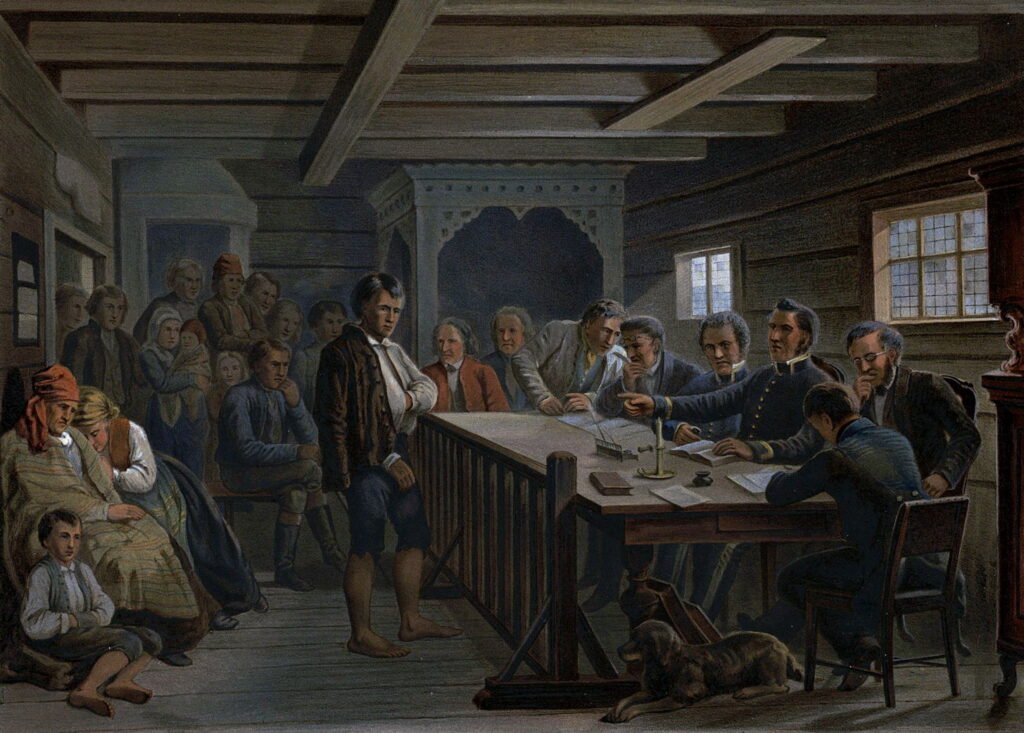Reading visual art: 155 Courts of law B

As lawyers rose to prominence in life during the nineteenth century, two artists in particular targeted them with their scathing satire: Honoré Daumier and Jean-Louis Forain.
Honoré Daumier (1808–1879), Three Lawyers (1855-57), oil on canvas, 16 x 12.75 cm, The Phillips Collection, Washington, DC. Wikimedia Commons.
For the satirical eye of Honoré Daumier, Three Lawyers (1855-57) meeting was the gathering of an elite who were out to help themselves, rather than the unfortunate people they purported to represent. Their heads tipped back and clutching thick bundles of papers, Daumier had less respect of them than they had for themselves.
Honoré Daumier (1808–1879), Two Lawyers Conversing (date not known), black chalk and gouache in white and grey with some pale pink, yellow, and brown watercolour, 20.9 x 27 cm, The Morgan Library & Museum, New York, NY. Wikimedia Commons.
In his undated Two Lawyers Conversing, you can be sure that they’re up to no good, except for themselves.
Jean-Louis Forain was a successful painter, caricaturist and political satirist in the late nineteenth century, who had long admired Daumier’s work. When Forain turned his attention to justice and the law after about 1902, he went beyond Daumier’s biting images of lawyers by entering the courtroom itself.
Jean-Louis Forain (1852-1931), The Court (c 1902-03), oil on canvas, 60.3 x 73 cm, The Tate Gallery (Purchased 1918), London. Photographic Rights © Tate 2018, CC-BY-NC-ND 3.0 (Unported), http://www.tate.org.uk/art/artworks/forain-the-tribunal-n03288
Forain’s The Court from about 1902-03 is one of the first of his series of courtroom views, and most neutral in its approach. In the foreground, a lawyer discusses the case with a woman, who is bent forward to hear his whispering. In the distance the court appears detached, perhaps disinterested, the judges sat behind large piles of papers, under a large painting of the crucifixion. The artist sold this work to Edgar Degas.
Jean-Louis Forain (1852–1931), Trial Scene (1904), oil on canvas, 61 x 81.2 cm, Private collection. The Athenaeum.
By the time that Forain painted this Trial Scene from 1904, his satire had come to the surface. The court here is so completely disinterested in the case before it that its judge is incapable of remaining awake, and the jurors at the left are hardly attentive either.
Jean-Louis Forain (1852-1931), Scene at the Tribunal (1906), media and dimensions not known, Private collection. The Athenaeum.
A young woman stands out in Forain’s Scene at the Tribunal (1906), as a lawyer turns and scowls disapprovingly at her.
Jean-Louis Forain (1852-1931), Scene of the Tribunal (1910), oil on canvas, 61.1 x 73.4 cm, Amgueddfa Cymru, Cardiff, Wales. The Athenaeum.
Two women are shown in his Scene of the Tribunal from 1910, a lawyer talking to them as the court appears oblivious to their presence.
Jean-Louis Forain (1852-1931), Legal Assistance (c 1900-12), oil on canvas, 61 x 73 cm, The National Gallery (Sir Hugh Lane Bequest, 1917), London. Courtesy of and © The National Gallery, London.
Legal Assistance (c 1900-12) shows an ordinary family man, cradling his young child in his arms as he presents a paper to a barrister or judge (wearing his short cylindrical hat). This painting was bought by Henri Rouart, an industrialist who was a good patron of the arts, as well as a fine amateur painter himself.
Jean-Louis Forain (1852–1931), Recess of the Court (date not known), oil on canvas, 60.6 x 73.3 cm, The Metropolitan Museum of Art, New York, NY. Wikimedia Commons.
Sadly only available in this monochrome image, Forain’s undated painting of Recess of the Court is his most scathing. The judge leans back, fast asleep, as chaos takes hold in the court. Laywers are talking among themselves, and furniture is being moved around. Where is justice?
It wasn’t until the nineteenth century that a growing interest in contemporary courts, and well-publicised trials, made them more popular in paintings. As few people ever see the inside of a courtroom, one of the first tasks of artists was to reveal what they looked like.
Thomas Rowlandson (1756–1827) and Augustus Charles Pugin (1762–1832), The Old Bailey, Known Also as the Central Criminal Court (1808), aquatint by John Bluck and others, plate 58 in ‘Microcosm of London, further details not known. Wikimedia Commons.
Thomas Rowlandson and Augustus Pugin’s painting of The Old Bailey, Known Also as the Central Criminal Court from 1808, here seen in an aquatint, is a good topographic view of this most famous English court. The presiding judge sits under a Damoclean sword of justice at the left, and the twelve men of the jury are to the right of centre. At the far right stands the accused, in front of whom is a large collection of witnesses ready to testify.
Adolph Tidemand (1814–1876), Scene before a Magistrate in the Country (before 1858), lithograph by Winckelmann & Sönner, Berlin, further details not known. Wikimedia Commons.
That was, and remains, an exceptional court. More typical of the type of court that ordinary citizens might encounter is Adolph Tidemand’s Scene before a Magistrate in the Country (before 1858), seen here in a lithograph. Set somewhere in rural Norway, the bench of magistrates sits at the right in more cramped and modest surroundings. Its justice may have been rougher, but the experience was far less daunting, and less overwhelmed by lawyers.
Ferdinand Brütt (1849-1936), Before the Judges (1903), oil on canvas, 80 x 115 cm, location not known. Wikimedia Commons.
Ferdinand Brütt’s Before the Judges from 1903 shows the end of an era in the courtroom, as an official lights the candles in its chandelier, and its three judges sit hearing the case being put to them.




